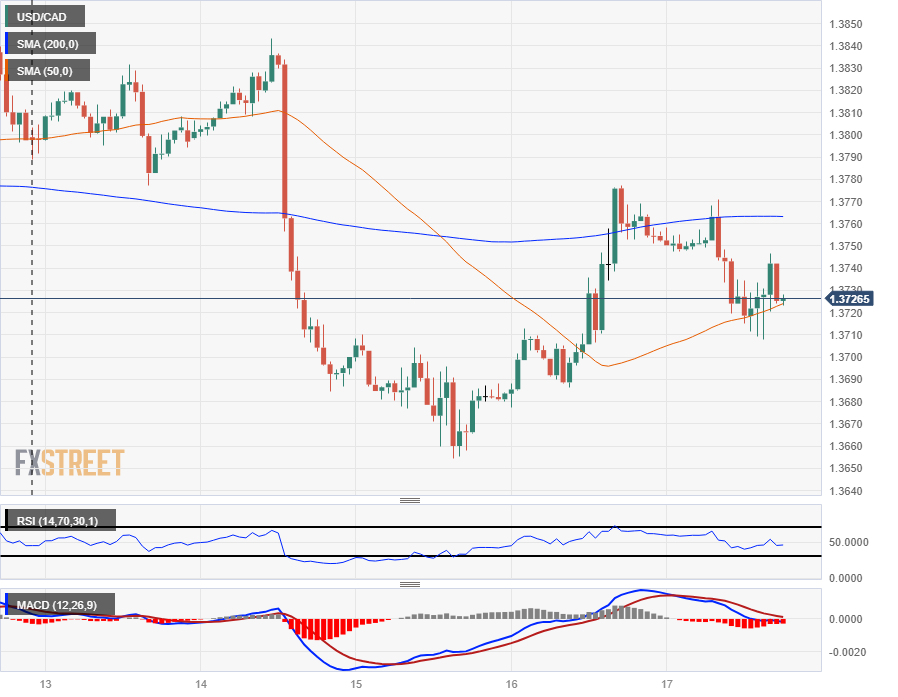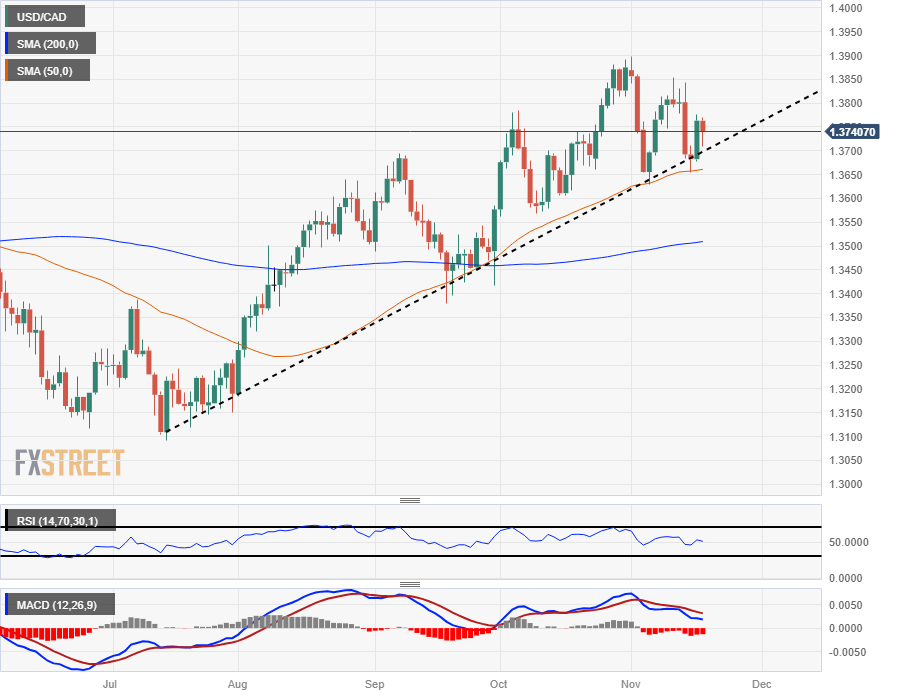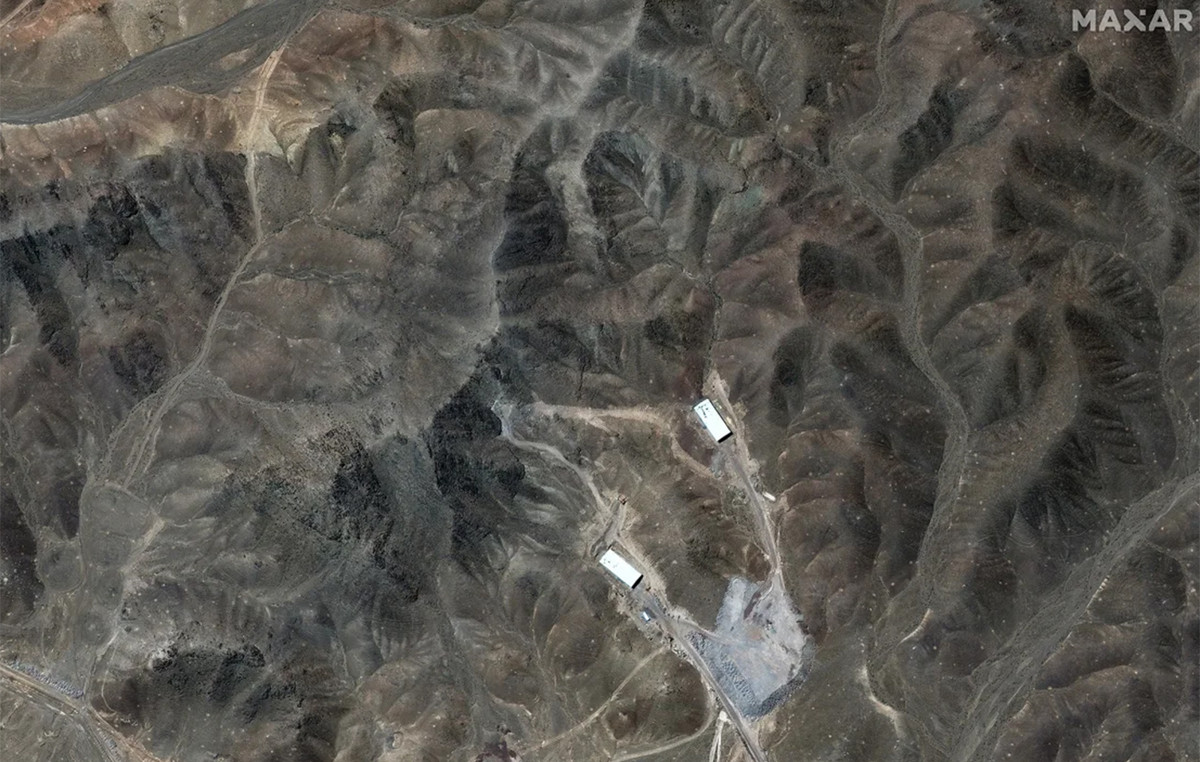- The CAD rebounded on risk appetite in early trading on Friday.
- Industrial inflation figures in Canada were better than expected.
- US Dollar and Fed reaction boost markets today.
He Canadian dollar (CAD) is trying to trim some of Thursday’s losses, getting some support from crude oil bids, but downside risks remain.
For the week, the Canadian dollar rose about half a percentage point against the US dollar.
Canadian industrial inflation numbers clashed with U.S. housing data on Friday morning, but overall, risk sentiment appears to be the main driver of moment-to-moment market moves.
Daily Market Summary: Canadian Dollar Unable to Develop Uptrend at Week End
- The Canadian Commodity Price Index for October showed a decline of 2.5% following September’s 3.9% increase (revised from 3.5%).
- Inter-monthly prices of industrial products in October also fell 1%, contraction from the previous 0.4%.
- U.S. building permits and home construction exceeded expectations, helping to stem the dollar’s decline early Friday and capping CAD gains.
- The U.S. economy recorded 1.487 million new construction permits, exceeding the forecast of 1.45 million and surpassing the previous month’s 1.471 million.
- The monthly number of housing starts also improved and stood at 1.372 million, compared to the forecast of 1.35 million. In September, work began on 1,346 million new residential buildings.
- Crude oil rose on Friday, boosted by rumors of new EU sanctions on Russian crude exports.
- After a week of ups and downs in trading, the CAD remains in Friday’s mid-trading range.
- The overall trading week was also lackluster for the CAD as the USD boosted the broader market.
Technical Analysis: The Canadian Dollar remains in the middle zone of the session on Friday, while the markets doubt its direction
The Canadian Dollar (CAD) is testing chart territory below 1.3750 against the US Dollar (USD), but the Loonie bids of the day are being threatened as USD/CAD bidders make a weak push.
The USD/CAD pair hit a daily low at 1.3708 before registering a slight rebound towards 1.3740.
The pair hit a mid-week high near 1.3780 on Thursday, and CAD bidders have been struggling to clip the bounce from the mid-week low near 1.3660.
Daily candles have USD/CAD consolidating in a rough trade just above the 50-day SMA, and technical indicators are starting to grind towards the center.
USD/CAD Hourly Chart
 USD/CAD Daily Chart
USD/CAD Daily Chart

Quote of the Canadian Dollar this week
Below is the percentage change of the Canadian Dollar (CAD) against the main currencies listed for this week. The Canadian dollar was the strongest currency against the US dollar.
| USD | EUR | GBP | CAD | AUD | JPY | NZD | CHF | |
| USD | -1.78% | -1.64% | -0.42% | -2.03% | -1.13% | -1.29% | -1.72% | |
| EUR | 1.75% | 0.13% | 1.32% | -0.24% | 0.64% | 0.48% | 0.06% | |
| GBP | 1.61% | -0.14% | 1.19% | -0.38% | 0.49% | 0.35% | -0.08% | |
| CAD | 0.42% | -1.35% | -1.21% | -1.59% | -0.71% | -0.86% | -1.29% | |
| AUD | 1.98% | 0.24% | 0.37% | 1.56% | 0.87% | 0.72% | 0.29% | |
| JPY | 1.11% | -0.63% | -0.48% | 0.69% | -0.90% | -0.12% | -0.58% | |
| NZD | 1.27% | -0.49% | -0.36% | 0.83% | -0.73% | 0.14% | -0.43% | |
| CHF | 1.68% | -0.07% | 0.07% | 1.26% | -0.32% | 0.56% | 0.41% |
The heat map shows the percentage changes of the major currencies against each other. The base currency is chosen in the left column, while the quote currency is chosen in the top row. For example, if you choose the euro in the left column and scroll down the horizontal line to the Japanese yen, the percentage change shown in the box will represent EUR(base)/JPY(quote).
Inflation FAQ
What is inflation?
Inflation measures the rise in prices of a representative basket of goods and services. General inflation is usually expressed as a percentage of inter-monthly and inter-annual variation. Core inflation excludes more volatile items, such as food and fuel, which can fluctuate due to geopolitical and seasonal factors. Core inflation is the figure economists focus on and is the target level of central banks, which are mandated to keep inflation at a manageable level, typically around 2%.
What is the Consumer Price Index (CPI)?
The Consumer Price Index (CPI) measures the variation in prices of a basket of goods and services over a period of time. It is usually expressed as a percentage of inter-monthly and inter-annual variation. Core CPI is the target of central banks as it excludes food and fuel volatility. When the underlying CPI exceeds 2%, interest rates usually rise, and vice versa when it falls below 2%. Since higher interest rates are positive for a currency, higher inflation usually translates into a stronger currency. The opposite occurs when inflation falls.
What is the impact of inflation on currency exchange?
Although it may seem counterintuitive, high inflation in a country drives up the value of its currency and vice versa in the case of lower inflation. This is because the central bank will typically raise interest rates to combat higher inflation, attracting more global capital inflows from investors looking for a lucrative place to park their money.
How does inflation influence the price of Gold?
Gold was once the go-to asset for investors during times of high inflation because it preserved its value, and while investors often continue to purchase gold for its safe haven properties during times of extreme market turmoil, this is not the case. most of the time. This is because when inflation is high, central banks raise interest rates to combat it.
Higher interest rates are negative for Gold because they increase the opportunity cost of holding Gold versus an interest-bearing asset or placing money in a cash deposit account. On the contrary, lower inflation tends to be positive for Gold, as it reduces interest rates, making the shiny metal a more viable investment alternative.
Source: Fx Street
I am Joshua Winder, a senior-level journalist and editor at World Stock Market. I specialize in covering news related to the stock market and economic trends. With more than 8 years of experience in this field, I have become an expert in financial reporting.







